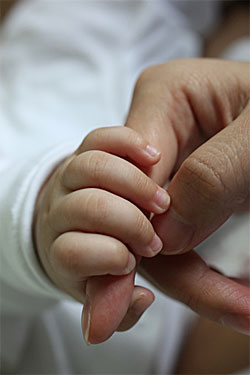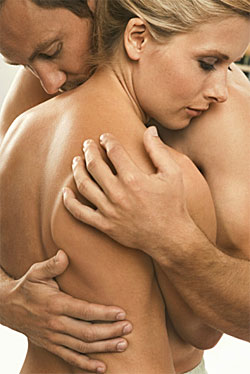A Short Introduction in the Art of Caressing (I)
after L’Art des caresses by Gérard Leleu
 We wonder how much our eyes, ears and mouth perceive. And yet, the most generous of our sense organs is the skin. It has the most extended surface area: for the average adult human it has a surface of 18,000 square centimeters, while a newborn’s skin surface area is 2,500. The sensory organs corresponding to the other senses have only a few centimeters. The skin is also the richest organ in receptors: a total number of 1,500,000. ”Next to the brain, the skin is the most important of all our organ systems”, says Ashley Montagu; he adds: ”A human being can spend his life blind and deaf and completely lacking the senses of smell and taste, but he cannot survive at all without the functions performed by the skin.”
We wonder how much our eyes, ears and mouth perceive. And yet, the most generous of our sense organs is the skin. It has the most extended surface area: for the average adult human it has a surface of 18,000 square centimeters, while a newborn’s skin surface area is 2,500. The sensory organs corresponding to the other senses have only a few centimeters. The skin is also the richest organ in receptors: a total number of 1,500,000. ”Next to the brain, the skin is the most important of all our organ systems”, says Ashley Montagu; he adds: ”A human being can spend his life blind and deaf and completely lacking the senses of smell and taste, but he cannot survive at all without the functions performed by the skin.”
Few people know how extremely sensitive the skin is. Many people consider skin a coarse sense organ that feels stimuli vaguely if they are not strong; the sense of touch seems to a superficial view the most primitive of all five senses, below sight and hearing, which are considered the most „noble” of the senses. But we are wrong: it is the most refined of all. Some areas of the skin may discern weights of 2 mg or a 1 mm distance between the two spikes of a pair of compasses. The skin can better appreciate the differences in contact than the ear does for the intervals between two notes. (An interval is the difference between two pitches). If the skin is subjected to a rapid vibration frequency, it can detect interruptions of 10 milliseconds.
Finally, in the skin, especially in the dermis, there are blood vessels; the most erogenous zones are prominently vascular, hence the red colour of the lips, nipples, vulva and vagina. Blood vessels gather here in plexuses – very dense networks of blood vessels – and in erectile tissues – true blood sponges.
The Extraordinary Sensitivity of the Hand
The extraordinary sensitivity of the human hand – and especially of the fingertips – is demonstrated, if still needed, by the following findings:
– is capable to detect a pressure of 2mg, as opposed to 20 mg, on the average, in other areas of the body;
– is able to detect a distance as small as 1 mm between the two spikes of a pair of compasses; as opposed to 30 mm, on the average, in other areas of the body;
– contains almost 135 sensory receptors per square centimeter, as opposed to other areas of the body, where there are between 5 and 50 sensory receptors per square centimeter;
– the surface of the cerebral cortex which corresponds to the skin of the hands is larger than that which corresponds to all other parts of the body. In other words: the area of cortical projection of the cutaneous sensitivity of the hand is as large as the totality of the areas of the other parts of the body (with the exception of the mouth). A hand is worth the upper limbs, the trunk in its entirety, plus the legs, together.
Let us also mention that the mouth (the lips, the oral cavity and the tongue), an equally important agent for caressing, is also amply represented in the cortex: its area of projection is comparable to that of the hand.
Through the skin we learn love
 Through the skin we learn love. “Through the skin we become beings capable of loving – as we do not learn to love from books, but only through being loved” (Ashley Montagu). Skin contact means at the same time emotion, communication, protection. But it means also merging and even more – symbiosis. Feeding the baby, cleaning it, putting it to bed are not mere dietary and hygienic care offered in a mutual neutrality. These activities are strongly imbued with eroticism and emotionality. For now, a whole range of emotions related to pleasure, wellbeing, joy, is developed. ”Since the early months of life, emotional exchange becomes more important than nutrition, on which, however, survival depends.” Affectionate caresses are then as necessary as food.
Through the skin we learn love. “Through the skin we become beings capable of loving – as we do not learn to love from books, but only through being loved” (Ashley Montagu). Skin contact means at the same time emotion, communication, protection. But it means also merging and even more – symbiosis. Feeding the baby, cleaning it, putting it to bed are not mere dietary and hygienic care offered in a mutual neutrality. These activities are strongly imbued with eroticism and emotionality. For now, a whole range of emotions related to pleasure, wellbeing, joy, is developed. ”Since the early months of life, emotional exchange becomes more important than nutrition, on which, however, survival depends.” Affectionate caresses are then as necessary as food.
Over our entire life, skin contacts maintain a deep emotional charge: „From the moment the contact between two skins exceeds the wrist…, the emotional and affective impact is always considerable” (Pierre Bour). Skin relations between women and men are not some trivial provision of material and sexual services. They are filled with sentimental value – therefore we can say that the skin is a source of feelings.
Feelings are transmitted and skin-to-skin contact represents real communication. Through the skin, the baby feels its mother’s moods, her love, her solicitude or (on the contrary) her lack of tenderness, anxiety, fatigue. Conversely, mother senses through the skin if the baby is well or sick. In the case of adults, not only the blind hear or ”talk” via the skin. A contact is often more eloquent than speech, especially between lovers.
Contact often means: ”Relax, my child”. It provides the baby, who is assaulted by the outside world in a thousand ways, the best protection; it is really a safe harbour. Similarly to the baby monkeys observed by Harlow, the child gradually learns to move away from this safe harbour to make a series of increasingly bold walks, but at the slightest inconvenience, he runs back to his mother, as if she were a refuge. The adults keep throwing themselves into the arms of another human being, when they are overwhelmed with fatigue, worries or deceptions. Men or women, we like to be held or hugged, by someone we trust. This intimate contact calms and comforts. Both babies and lovers fall asleep on the chest that soothes them, making them feel safe.
Even in love each finds its role, both the one who caresses and the one who is being caressed. The one who offers becomes more powerful through what he offered and his sensuality becomes enriched through what he planted. Sowing pleasure, we gather joy, offering caresses, we receive tenderness.
The Benefits of Caresses
 We instinctively know the benefits of the contact between the hand and the body, and in a broader sense, the benefits of skin-to-skin contacts. Mother puts her hand on the tummy of her baby who is suffering from colic and kisses the spot where it got hurt or burned.
We instinctively know the benefits of the contact between the hand and the body, and in a broader sense, the benefits of skin-to-skin contacts. Mother puts her hand on the tummy of her baby who is suffering from colic and kisses the spot where it got hurt or burned.
Even as adults, we still resort to this kind of comfort. For the doctor or friend who calms the sufferer, the griever or the one who is seized by anguish, brings relief with his compassionate and comforting hand: a hand that touches, holds or even holds tight.
Unfortunately, these practices are becoming increasingly rare. On the one hand, the sense of touch becomes forgotten and a means of communication more and more neglected. On the other hand, the use of medication, as an easy way and due to the „technicization” of our behaviours, becomes almost automatic. Pain = analgesic drugs, anxiety = tranquilizers, contractures = muscle relaxants, etc. But what if instead of taking a pill or hurrying to the doctor for the smallest sore, we touched, we caressed, we massaged ourselves? How much we would save on drugs! How much the Health Insurance Companies would save!
Let us now see at the various levels of our being which are the benefits of caresses and massage.
Effects on the Skin
Tactile contact activates blood flow. This causes vasodilation of arterioles and capillaries which generates an influx of fresh blood and thus of oxygen and nutrients. Venous drainage also occurs, leading to an improved venous return and therefore to the discharge of toxins (urea, uric acid, lactic acid, CO2, etc.) Tactile contact enables exchanges between blood vessels, the interstitial environment and the cells, exchanges that have a role in nutrient intakes and the elimination of toxins. Through these two actions, tactile contact generates a firmer skin.
Tactile contact stimulates the production of antibodies by the mast cells, which increases immunity (increases the capacity of defense against microbes). Tactile contact improves skin diseases, especially eczema, urticaria, psoriasis. Which is not surprising when we know the connection between these diseases and anxiety and the extent to which our “nerves” are calmed through physical contact. As far as the close relation between the psyche and the skin is concerned, it can be explained by their common embryological origins and by the role of epidermis in shaping our personality.
(to be continued)
yogaesoteric
July 2016
Also available in:
 Română
Română
